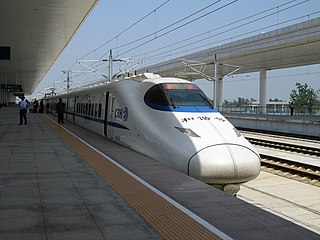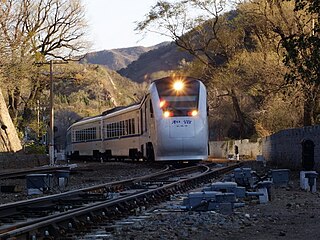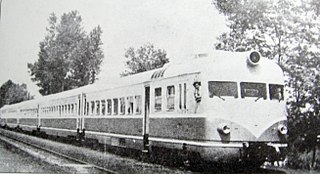CRRC Tangshan Co., Ltd., is a manufacturer of rolling stock located in Tangshan, Hebei province, People's Republic of China. While Datong built mainline steam locomotives until 1988, Tangshan built steam for industrial use until 1999, becoming the last works in the world to build steam for non-tourist use.
China Railway High-speed (CRH) is a high-speed rail service operated by China Railway.

The DF8 is a type of diesel locomotive used in China. It was in production from 1984 until mid-1990s, with mass production starting in 1989. The revised DF8B is still in production today. DF8 are almost exclusively used for freight services.

The CRH3 Hexie is a version of the Siemens Velaro high-speed train used in China on the Beijing–Tianjin intercity railway line, Wuhan-Guangzhou Passenger Dedicated Line, Zhengzhou-Xi'an Passenger Dedicated Line and the Shanghai–Nanjing intercity railway. It is capable of service speed of 380 km/h (236 mph) as the very similar Velaro E used in Spain, but, similarly to the Sapsan, it is 300 mm (11.8 in) wider to take advantage of a more generous structure gauge and thus be able to fit in more seats in a 2+3 layout.

The CRH5 Hexie is an electric multiple unit high-speed train in use with China Railway High-speed in the People's Republic of China. The CRH5 is based on the ETR-600 New Pendolino used in Italy.

The China Railways "Dongfang Hong" diesel-hydraulic locomotive classes DFH2, DFH5, DFH6, and DFH7, built from the 1970s to 1990s, were all used as shunters on the Chinese railway network.

The HXD2 is an electric locomotive and a series of related locomotive classes built by CNR Datong Electric Locomotive and Alstom. The locomotives designs are based on the Alstom Prima electric locomotives, and are a product of a cooperation agreement signed between the two companies in 2004. All locomotives are intended for heavy freight work, including coal trains on the Datong Qinhuangdao line.

The DF5 is a diesel-electric locomotive used by China Railway in the People's Republic of China. It has been in production since 1976 and is still produced as of 2006 by several local companies. It is the most common road switcher in China and is used for yard and road switching duties. A small number are also in service with the Korean State Railway in North Korea.

The HXN5B, is a diesel-electric locomotive used by China Railway in the People's Republic of China. It has been in production since 2012. It is a new-generation road switcher type made in China and used for yard and road switching services.

Hexie, also known as the CRH series EMU, is an umbrella term for the multiple unit high-speed and higher-speed trains operated by China Railway under the China Railway High-speed brand. All series of Hexie are based on foreign-developed technology and later manufactured locally in China through technology transfer licenses, with the ultimate goal of China acquiring the know-how and capability to produce high-speed rail trains.

The CR200J Fuxing is a Chinese higher-speed trainset consisting of a power car paired with unpowered passenger cars operated by China Railway. It is the slowest member of the Fuxing series. The train was jointly designed and produced by six companies under CRRC.

The DDJ1 is a first generation high-speed electric multiple unit built for China Railway, built by Zhuzhou Electric Locomotives, Changchun Railway Vehicles, Sifang Railway Vehicles, Tangshan Passenger vehicle factory, Nanjing Puzhen and developed by Zhuzhou Electric Locomotive Research Centre. It was built in 1999, and was an experimental vehicle, with only one set built, as it did not enter mass production. The design was well received as part of national science in the 9th five year plan. The DDJ1 is in a push–pull configuration, with only one locomotive in the set and the other end being a trailer with a driver's cabin.

The DJF2"Xianfeng" electric multiple unit is a model operated formerly by China Railway with traction motors distributed throughout the unit. It was developed in 2001 as a key task of the science and technology targets of the Ninth Five-Year Plan. It was an innovative and advanced design being the first Chinese multiple unit train to achieve 200 km/h (124 mph) and achieving a top test speed of 292.8 km/h (181.9 mph) in tests, but had numerous flaws in the design that complicated operations.

The NDJ3 "Great Wall", previously labeled the "Harmony Great Wall" is the only higher-speed diesel multiple unit that is still operating in China. It was first designed to be used for passenger transport in the 2008 Olympics, and has become a mature technology platform with export orders to Nigeria despite initial flaws related to overheating of electrical cables in the power car.

The Dongfeng diesel multiple unit, also known as the Dongfeng motor coach, and NM1, was a DMU of Ministry of Railways, and was also the first diesel-hydraulic power car and double deck passenger car of China, built by Qingdao Sifang in 1958. The train consisted two motors and four double deck trailers, and was designed for short, commuter services. Each motor has two DV12A high speed diesel engines, and has the SF2006-1 hydraulic transmission. As the set had numerous flaws, it never entered mass production, but the valuable experience gained in the design and manufacturing process was later applied to the DFH1 and Red Star-class locomotive, while the passenger cars designs were later further developed for double deck trains such as the NZJ.
The TSD09 diesel multiple unit is a tilting train developed by Tangshan Locomotive in 2003 and fitted with Cummins diesel engines, Voith hydraulic transmission and Extel Systems Wedel tilting mechanisms. It was built for Sanmao Railway, but due to strategic reasons within the Ministry of Railways, the set never operated commercially and has been permanently stored at Tangshan Locomotive.
The KDZ1 is the first electrical multiple unit built in China. It is an experimental alternating current electrical multiple unit, developed by Changchun Railway Vehicles, CRRC Zhuzhou Institute and China Academy of Railway Sciences in 1978 and completed in 1988, though it never saw passenger service, with it being stored after it completed its initial tests.

The DJF1 "Zhongyuan Star" was an electric multiple unit of China Railway. It only operated in service for less than five years, before it was removed from service due to its various flaws and high maintenance costs. The train was initially built as a six car set, and subsequently lengthened to a fourteen car set. The two driving motors and the middle two motor cars have been preserved, with the other carriages being scrapped.

The KDZ1A "Chuncheng" was an early attempt at building an electric multiple unit in China with the participation of Changchun Railway Vehicles, Zhuzhou Institute and Kunming railway bureau. Development was completed in 1999 in time for the Kunming World Horticultural Exposition. As its predecessor, the KDZ1 never operated commercially, the KDZ1A became the first Chinese EMU to be in revenue service, although it was in service for only 10 years before being withdrawn.

The NC3 are a model of diesel multiple units operated by China Railway. They were built by Ganz-MAVAG in 1962 and imported from the Hungarian People's Republic to be operated in China. They were not the first DMU to be operated in China; the Dongfeng DMU had been built a few years earlier, but only in a single set.

















